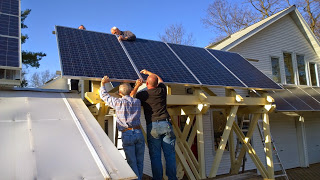
by jboullion | May 14, 2015 | Uncategorized
After winning two court victories in the past 12 months, RENEW Wisconsin is seeking another legal triumph. RENEW Wisconsin and The Alliance for Solar Choice (TASC) are teaming up in a legal challenge to a Wisconsin Public Service Commission’s December 2014 decision, which approved a “tax on clean energy” for customers choosing to power their homes and businesses with renewable energy in We Energies territory. RENEW and TASC argue there is insufficient evidence in the record to support the added tax, and are asking the Dane County Circuit Court to reverse the PSC’s decision.
RENEW Wisconsin and TASC filed their legal arguments on Thursday, May 14th. Our press release below highlights our arguments.
To help fund our lawsuit and our continued advocacy work for expanding clean energy in Wisconsin, please visit our website. Donate now, and help us get bigger and stronger to take on We Energies.
Solar Groups Take Next Step in Appeal of Public Service Commission Decision on 2014 We Energies Rate Case
 |
A residential solar installation on the home of
RENEW Wisconsin members Steve and Ellen Terwilliger |
MADISON, WI – May 14, 2015 – The Alliance for Solar Choice (TASC) and RENEW Wisconsin today took their next steps in appealing the Wisconsin Public Service Commission’s December 2014 decision to add a discriminatory fee on distributed generation customers in We Energies’ territory.
The groups filed the first set of briefs Thursday, which outlined their arguments in the case. TASC and RENEW Wisconsin explain in the briefs how the record does not contain the necessary evidence to support the Commission’s approval of the additional charge on customer generation (like solar energy).
“The Court must reverse when the Commission’s action depends on any finding of fact that is not supported by substantial evidence in the record,” said Amy Heart, spokesperson for The Alliance for Solar Choice. “Here, the Commission’s own expert witness testified that there was not enough evidence on the record to approve the discriminatory solar charges.”
In fact, Heart pointed out that We Energies’ own study of the costs and benefits of solar in their service territory found that these customers provide a net benefit to all ratepayers. “Unfortunately, the Commission, knowing the benefits, still approved fees for these self-generating customer, which was legally improper,” said Heart.
This is the third case in the past three years seeking judicial review of a decision of the Public Service Commission of Wisconsin that discriminates against owners of small distributed renewable energy generating systems. In the previous two cases, the Dane County Circuit Court also remanded all or part of the new rates as lacking a factual basis in the administrative record.
“It is important that we promote and defend Wisconsin renewable energy in all decision-making venues, and in this case that means the courts,” said Tyler Huebner, RENEW Wisconsin’s Executive Director. “A customer’s own investment in solar and other clean energy technologies benefit everyone, and impartial analysis in multiple states proves that. Beyond that, from a public policy perspective, there is significant job creation and economic gains for Wisconsin on the horizon if we can get these policies right.”
The We Energies rate case in fall 2014 sparked unprecedented public opposition and national attention for the three-member Commission, with over 500 Wisconsin residents in attendance at a public hearing in October. Along with the discriminatory rate changes, both groups protested Commissioner Ellen Nowak’s lack of impartiality during the proceeding.
About The Alliance for Solar Choice: The Alliance for Solar Choice (TASC) leads the rooftop solar advocacy across the country. Founded by the largest rooftop companies in the nation, TASC represents the vast majority of the distributed solar market.
About RENEW Wisconsin: RENEW Wisconsin leads and accelerates the transition to Wisconsin’s renewable energy future through advocacy, education, and collaboration. RENEW represents over 50 Wisconsin businesses in the renewable energy industry and hundreds of customers who have installed their own renewable energy systems.
More information:
Kelly Trombley, Associate
The Alliance for Solar Choice
925.989.7615
kelly@allianceforsolarchoice.com
Tyler Huebner
RENEW Wisconsin
608-575-2201tyler.huebner@renewwisconsin.org

by jboullion | May 13, 2015 | Uncategorized
 |
Vernon Electric Cooperative’s
Community Solar Project in Westby, WI |
Xcel Energy’s Wisconsin affiliate, Northern States Power Company (NSPW), is seeking approval to launch a pilot solar garden program. This is the first formal proposal from a Wisconsin investor owned utility to offer solar subscriptions to its customers. Under the program, Xcel Energy would purchase up to three megawatts (3,000 kilowatts) of electricity from local community solar arrays in the company’s service area in western and northern Wisconsin. Customers would in turn subscribe for capacity to meet their desired solar energy needs up to their annual usage and receive a monthly credit for their subscription. If approved as is, the monthly credit would be 7.4 cents per kWh for residential customers and 6.9 cents per kWh for business customers. NSPW will set the subscription price based on the results of its solicitation.
Update: On a 3-0 vote, the Public Service Commission approved Xcel’s pilot program as proposed. Check our website for details about the program’s rollout.
RENEW submitted the comments below prior to the commission’s deliberation of NSPW’s solar garden proposal:
222 S. Hamilton, Madison, WI 53703
May 13, 2015
Ms. Sandra Paske
Public Service Commission of Wisconsin
610 N. Whitney Way
Madison, WI 53707-7854
RE: Application of Northern States Power Company, a Wisconsin corporation, for Approval to Implement a Community Solar Garden Pilot Program (Docket No. 4220-TE-101)
Dear Ms. Paske:
On behalf of RENEW Wisconsin, I would like to submit these brief comments on the above-mentioned application filed by Northern States Power Company (NSPW) on April 27, 2015. Our comments are as follows.
Items we support:
- According to a study from the National Renewable Energy Laboratory, about 75% of residential rooftop area is not suitable for installing solar panels, either because the roof is shaded or is not oriented properly, or because the customer doesn’t own their home or building. We commend NSPW for offering a pilot program to begin exploring how to meet the solar energy interests of such customers.
- This pilot program, if approved, will be useful in exploring how “community solar gardens” can be effectively designed and operated in Wisconsin by regulated electric providers.
- We commend NSPW for deciding to acquire solar capacity through a competitive request for proposal process. This will ensure all parties that NSPW will acquire the projects’ output at a competitive, market-based cost.
- As proposed, this program would operate outside of NSPW’s rate base, like its voluntary green pricing program. The proposed bill credit has been set to compensate customers based on NSPW’s costs. Customers should instead be compensated based on what their investment in solar is actually worth. Robust empirical studies have been conducted in multiple states which conclude that there are additional financial benefits of solar over the lifetime of the project. A more complete analysis of these benefits should be conducted, with NSPW and stakeholders, to improve the bill credit level.
- We commend NSPW on offering a program that enables the participants to directly contribute to increased renewable generation capacity. New participants in some utility green pricing programs do not necessarily lead to additional renewable energy capacity; that would not be the case here.
- We believe success of this pilot, if approved, will be determined initially by two factors: (1) interest from solar developers under the proposed parameters, and (2) customer interest, which will be driven by the perceived value of the offer based on the final subscription price and bill credit level. Both of these factors would be enhanced if NSPW works with stakeholders to improve the formula for calculating bill credits, as suggested above.
Thank you for the opportunity to provide these comments.
Sincerely,
Tyler Huebner
Executive Director
by jboullion | May 4, 2015 | Uncategorized
The below article appeared in the Sunday May 3rd edition of the Wisconsin State Journal, and argues that the Joint Finance Committee should restore funding for CUB and other advocates to ensure ordinary ratepayers have a voice on their side.
When you spread the cost of the Citizens’ Utility Board across all of the ratepayers in Wisconsin, it’s no more than a penny a month on your utility bill.
“I actually think it’s less than that because it gets spread across electric bills and gas bills and water,” CUB executive director Kira Loehr said Thursday.
That penny provides a lot of pop for the public.
CUB has successfully argued before the state Public Service Commission against rate hikes sought by utilities. Those efforts have saved ordinary ratepayers — homeowners, renters and small business people — real money.
In the last year alone, CUB has helped convince the PSC to reduce proposed rate hikes saving customers more than $160 million. The PSC might have scaled back some of those utility requests on its own. But the professional analysis and testimony of CUB played an important role.
In fact, the PSC is not required to grant CUB the $300,000 it receives from ratepayers each year. The PSC approves the expense because it values CUB’s input and knowledge. The PSC late last year called CUB “active,” “professional,” “forthcoming, prudent and worthy of this nominal award.”
Unfortunately, CUB is now at risk. The Legislature’s budget committee just nixed the $300,000 payment and made it harder for CUB to hire outside experts to testify at hearings on behalf of consumers.
Republicans who control the Joint Finance Committee claim the change will save ratepayers money. Sure, a few pennies a year.
But that savings will be imperceptible and will certainly lead to costly hikes in utility rates over time. That’s because CUB’s four-member staff won’t be carefully following and sticking up for ratepayers in dozens of cases before the PSC.
The PSC lets utilities hire expensive lawyers and consultants to plead their cases for higher rates, with the cost of that advocacy passed on to ratepayers. So it’s only fair for ordinary ratepayers to have a voice, too.
The Metropolitan Milwaukee Association of Commerce is spearheading the effort to scrub CUB, according to the Milwaukee Journal Sentinel. The MMAC has disagreed with CUB in cases affecting how much Milwaukee businesses, versus general customers, will pay for power.
You can’t fault MMAC for trying to control its costs. But you should fault the Joint Finance Committee for trying to eliminate a strong advocate for ordinary ratepayers.
Even utilities are defending CUB’s important role.
“We felt the CUB funding worked fine,” Gary Wolter, CEO of Madison Gas and Electric, told the State Journal editorial board Wednesday.
If the Joint Finance Committee doesn’t restore CUB funding, the full Legislature should. Ratepayers need this cost-effective advocate on their side.
Read more: http://host.madison.com/news/opinion/editorial/keep-cub-as-advocate-for-ratepayers/article_d49f266f-818a-5d86-a7f2-dad48c06f056.html#ixzz3ZBvNIclb
by jboullion | Apr 28, 2015 | Uncategorized
Following our press release yesterday, the Milwaukee Business Journal posted an article covering Ale Asylum’s climate forward actions. Find the article online
here.
Ale Asylum brewery adds solar panels and climate change pledge
Apr 27, 2015, 3:47pm CDT
Scott Paulus
The Ale Asylum brewery in Madison produces about 20,000 barrels of beer annually.
Ale Asylum, the Madison brewery with a 100-kilowatt rooftop solar electric system, has become the first Wisconsin brewery to sign a declaration to fight climate change being circulated by The Ceres Foundation.
More than 50 beer producers have signed the Brewery Climate Declaration, which holds that climate change caused by air pollution poses a threat and a challenge that must be addressed.
“And in doing this right, by saving money when we use less electricity, by driving a more efficient car, by choosing clean energy, by inventing new technologies that other
countries buy, and creating jobs here at home, we will maintain our way of life and
remain a true superpower in a competitive world,” the declaration says.
For its part, Ale Asylum installed the 480 solar panels that produce about 20 percent
of the electricity needed to operate its brewery and produce about 20,000 barrels of
beer each year.
“When we built our new facility, one of our goals was to increase our sustainability efforts,”
Dean Coffey, Ale Asylum brewmaster said. “These measures include recycling
spent grain to local area farmers, utilizing energy given off in the brewing process for
our tasting room, and harnessing the cold winter air to help keep our large walk-in
cooler at the proper temperature.”
Tyler Huebner, executive director of Renew Wisconsin, said a number of Wisconsin breweries, including MillerCoors LLC and Milwaukee Brewing Co., have taken
steps to reduce energy consumption and re-purpose waste. The Brewery Climate Declaration represents a “can-do” message to be followed by the 2,800 breweries
in the U.S., Huebner said.

by jboullion | Apr 27, 2015 | Uncategorized
 For immediate release
For immediate release
April 27, 2015
More Information
Tyler Huebner, Executive Director
608.255.4044
tyler.huebner@renewwisconsin.org
One month after activating a 100-kilowatt rooftop solar electric system, Madison-based Ale Asylum became the first brewery in Wisconsin to sign onto the Brewery Climate Declaration, a national campaign calling attention to the specific risks and opportunities of climate change on the $246 billion industry.
Launched this spring by Boston-based Ceres, a nonprofit advocacy organization, the Brewery Climate Declaration has attracted endorsements from more than 50 beer producers across the nation, ranging from local craft breweries like Ale Asylum to major international brands like Guinness and Sierra Nevada.
According to Ceres, these breweries “are showing their leadership and commitment to brewing with the climate in mind. They are already reducing greenhouse gas emissions, using less energy, choosing clean energy, and investing in new technologies.” The declaration states: “Leading is what we’ve always done. And by working together, regardless of politics, we’ll do it again.”
On Earth Day 2015 (April 22nd), Ale Asylum hosted a celebration of their solar-powered beer along with SunPeak, a Madison-based company who developed the rooftop system, and RENEW Wisconsin, a statewide renewable energy advocacy organization.
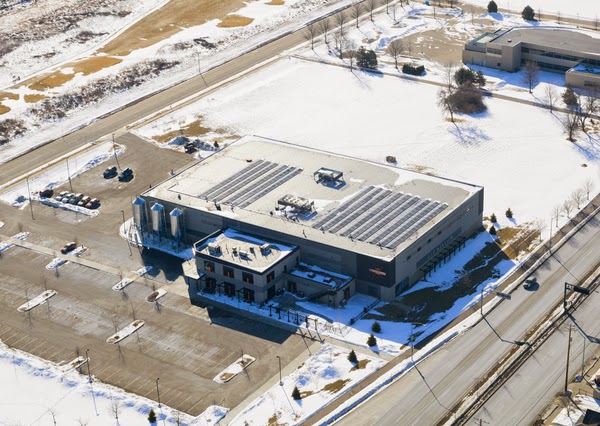 |
Overhead view of Ale Asylum’s solar
installation, courtesy of SunPeak |
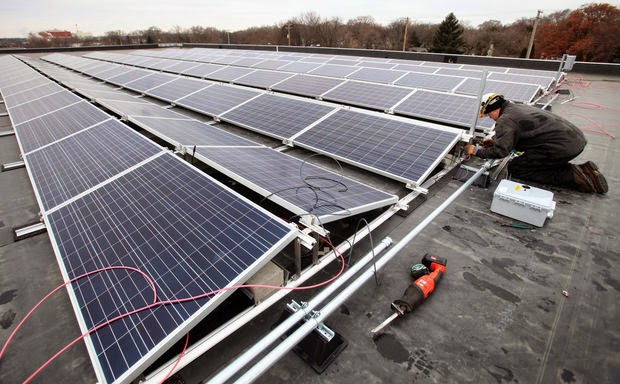 |
| SunPeak installer at work on Ale Asylum’s new array |
“When we built our new facility, one of our goals was to increase our sustainability efforts,” said Ale Asylum brewmaster Dean Coffey. “These measures include recycling spent
grain to local area farmers, utilizing energy given off in the brewing
process for our tasting room, and harnessing the cold winter air to help
keep our large walk-in cooler
at the proper temperature.”
“The solar panel installation came at a time where we were about to experience a huge spike in production needs,” Coffey added. “To be able to crank out beer while reducing
greenhouse emissions is a great thing!”
Ale Asylum’s array is the newest of a quartet of recent installations in Dane County equaling or surpassing 100 kilowatts (kW). The other three systems serve the City of Monona (156 kW), Holy Wisdom Monastery in Middleton (146 kW), and Dane County Airport’s new maintenance facility (100 kW).
Consisting of 480 panels facing east and west, Ale Asylum’s installation should generate about 150,000 kilowatt-hours per year, the most productive of any solar system
operating in Madison today. That is equivalent to the electricity needs
of about 16 average Wisconsin homes.“SunPeak’s niche is in dovetailing
international experience, where solar is far more mature and
established, with the U.S. market to uncover unique value creation and
proposition to larger customers like Ale Asylum,” said company president
Chad Sorenson.
“Ale Asylum’s solar installation and participation in this declaration demonstrate its committed corporate leadership. Going solar saves money, and Ale Asylum is just the latest example of this growing trend in Wisconsin,” said Tyler Huebner, Executive Director of RENEW Wisconsin.
For more information about Ceres’ Brewery Climate Declaration, see link below.
http://www.ceres.org/declaration/about/climate-declaration-campaigns/brewery
RENEW Wisconsin leads and accelerates the transformation to Wisconsin’s renewable energy future through advocacy, education, and collaboration. More information on RENEW’s web site at www.renewwisconsin.org.
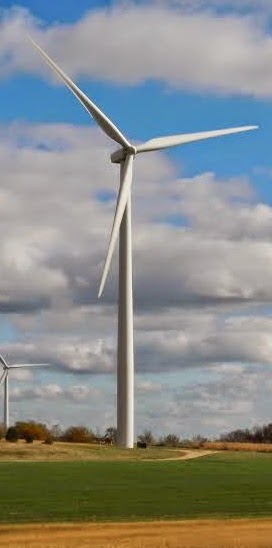
by jboullion | Apr 16, 2015 | Uncategorized
 Yesterday, April 15, the state legislature’s Joint Finance Committee met to decide the budget for the Public Service Commission.
Yesterday, April 15, the state legislature’s Joint Finance Committee met to decide the budget for the Public Service Commission.
Three items of importance to the renewable energy community.
1. Studying the health effects of wind: The Governor had proposed $250,000 to study health related impacts of wind energy. The funding was cut for that study, but the
Commission was directed to conduct a review of studies relating to
health effects of wind turbines. These studies do not have to be “peer
reviewed,” and a motion to include that phrase was shot down. If the
review shows substantial negative health effects, the PSC may submit
revisions to the existing rules pertaining to siting wind farms.
2. Higher utility bills likely coming your way: Out of seemingly nowhere, and as the last order of business of the day, an amendment surfaced to cut public funding for citizen participation in cases at the Public Service Commission. The motion was passed 12-4, with all Republicans voting for it.
In an article published in the April 19th Milwaukee Journal Sentinel, Tom Content reports that the amendment was the brainchild of the Metropolitan Milwaukee Association of Commerce (MMAC). Coincidentally enough, We Energies CEO Gale Klappa is vice-chairman of the MMAC board.
As discussed in a blistering Milwaukee Journal Sentinel editorial from the same day, the measure will lead to higher utility bills because it would slash funding for the Citizens Utility Board, or CUB, a nonprofit organization which advocates for lower utility expenses and bill savings to customers. In 2014 alone, CUB saved utility customers $161 million.
The editorial asks MMAC to explain to ratepayers across Wisconsin why it thinks eliminating CUB funding is such a good idea. The editorial calls on the budget committee to reconsider its “inexplicable decision to sock it to utility customers….And if it fails to do that, Gov. Scott Walker should find a way to restore CUB’s funding. Utility customers need a watchdog with teeth.”
The measure also cuts funding by 50% for groups like RENEW Wisconsin when we bring expert witnesses to utility cases on renewable energy issues.
 3. Focus on Energy. No action or amendments surfaced that would affect the Focus on Energy program. This is a good thing. However, it is highly likely that proposals to amend the program in some fashion may surface
3. Focus on Energy. No action or amendments surfaced that would affect the Focus on Energy program. This is a good thing. However, it is highly likely that proposals to amend the program in some fashion may surface
later this year, or perhaps even later on during this budget process.
We will continue to stay abreast of these discussions as they develop.
Upcoming calendar: Yesterday was the first meeting of the Joint Finance Committee, which is aiming to finish its work on the entire budget by Memorial Day. The budget must be passed by both the Senate and Assembly before the end of June, therefore none of these items are finalized at this point.
More details on the above items are found below:
Results from the Joint Finance Committee meeting, April 15, 2015, relating to the Public Service Commission’s budget
Motion #48 – Wind Energy Health Study
Joint Finance Committee approved a substitute motion to delete the Governor’s recommendation, including the appropriation of $250,000 from the 2015-2017 state budget, and “instead require the PSC instead to conduct a review of studies conducted to ascertain the health effects of industrial wind turbines on people residing near turbine installations. If the review shows that there are substantially negative health effects on people living beyond the current 1,250-foot setback radius, the PSC may submit necessary revisions to the existing administrative rules to the Legislative Council Rules Clearinghouse, not later than six months after completion of the study.”
The amendment was moved by Rep. Nygren and approved on a party line vote (12-4).
Joint Finance Committee rejected a motion (#55) to insert the words “peer-reviewed” before “studies” on line 2 of Motion #48 in the above motion on a party-line vote (12-4).
Motion #29 – Intervenor Compensation
Joint Finance Committee approved a motion to cut the intervenor financing budget and “repeal the authorization for grants to nonprofit corporations that have a history of advocating on behalf of ratepayers and by reducing the compensation rate for consumer groups and consumer representatives from 100% of the cost of participating in a PSC hearing to 50% of the cost.” Approval of this motion will “decrease expenditures from the appropriation by $671,300 PR annually. These provisions would become effective on July 1, 2015, or the day after publication of the budget act, whichever is later.” The amendment was approved on a party line vote (12-4).
Background information on this program:
The intervenor compensation program was created in 1983 and since that time, has provided financial assistance to organizations and individuals who choose to become an intervenor for a Commission proceeding. When organizations or individuals have been granted intervenor status, they may submit testimony and exhibits, which became part of the record considered by the Commission in making decisions. Typically, intervenors use the compensation to pay for expert witnesses. The motion would require the intervenor to pay for half of the costs it incurs.
The intervenor compensation program was modified by 2009 Wisconsin Act 383, which authorizes an annual grant of $300,00 to a nonstock, nonprofit corporation that has a history of advocating on behalf of residential ratepayers for affordable rates. The recipient is required to use the grant “for the purpose of offsetting the general expenses of the corporation, including salary, benefit, rent, and utility expenses.” In 2011, the grant program was modified to allow the PSC to distribute the $300,000 among more than a single group and impose additional conditions and to revoke a grant. Since its creation, the Citizens Utility Board has been the only grant recipient. The motion would repeal the grant.
The intervenor compensation appropriation is a biennial appropriation authorized to expend up to $1,042,500 annually ($300,00 for grants and $742,500 for compensation). The actual amount expended on intervenor compensation depends on the number of docketed cases, as well as other factors. Funds for the payments are generated through the PSC’s direct and remainder assessments on public utilities.
by jboullion | Apr 15, 2015 | Uncategorized
The article below teases out a recent rate case ruling in Minnesota and how it might affect an upcoming case in Wisconsin. In addition to being the largest electric utility in Minnesota, Xcel Energy also serves much of western Wisconsin, including La Crosse and Eau Claire. Right now, Xcel’s residential customers in both MN and WI pay a monthly fixed charge of $8.00.
Posted on 04/15/2015 by Kari Lydersen

(Photo by Jimmy Emerson via Creative Commons)
Utility rate cases have become a major battleground over the future of distributed solar generation and the evolving structure of the nation’s electricity system.
In the Midwest, Wisconsin has been ground zero, with state regulators last year approving three rate cases that made solar much less viable through several mechanisms, including a drastic increase in the fixed monthly charges for all ratepayers, regardless of how much electricity they use.
The next major development on that front will be a case that Xcel Energy is expected to file in late spring or summer. The Wisconsin Public Service Commission has made it clear that it welcomes requests for increased fixed charges and related measures, as RENEW Wisconsin program and policy director Michael Vickerman and other energy experts see it.
But a March 26 decision by the Minnesota Public Utilities Commission (PUC) on an Xcel rate case in that state could mean Xcel is unlikely to request the type of fixed rate increase that other utilities in Wisconsin have been granted.
In Minnesota, which along with North and South Dakota makes up about 85 percent of Xcel’s upper Midwest territory, the utility had requested a $1.50 increase in fixed charges each month. The Minnesota PUC allowed Xcel to collect more revenue and increase rates in general, but it denied the monthly fixed rate increases.
“Having a neighboring public service commission say no will hopefully warn that not everybody is marching forward” with fixed rate increases, said The Alliance for Solar Choice spokesperson Amy Heart. “That this isn’t necessarily a trend in the Midwest.”
“The decision in Minnesota demonstrates just how out of step the Public Service Commission is in Wisconsin.”
Paying for the grid
The fixed-rate portion of an electric bill is meant to cover the cost of grid infrastructure, and utilities around the country have argued that even when people reduce their energy use – including through solar installations – they still need to pay an increased “fair share” for keeping up the grid.
Since Minnesota essentially rejected that argument, and since the grid infrastructure delivering to Wisconsin Xcel customers is largely the same system as in Minnesota, experts say Xcel would have a hard time justifying higher fixed charges for Wisconsin customers.
In other words, if it costs only $8 a month to deliver electricity to Minnesota Xcel customers, it doesn’t compute that it would cost much more to deliver to customers only a few miles away over the Wisconsin border.
“They will be constrained internally from asking for a large increase in fixed costs, though it doesn’t mean they wouldn’t do it,” said Vickerman. “They would feel like, ‘Hmm, this could cause problems with respect to the other customers served by the Xcel system.”
Heart added that “our suspicion [and] hope is that it’s an indication that Xcel would be more judicious and cautious in their upcoming rate request in Wisconsin as to whether they would include any fixed rate increase.”
Xcel response
Xcel spokesperson Mary Sandok did not respond directly to questions about whether the company will seek higher fixed costs in Wisconsin and whether the Minnesota decision will affect the company’s Wisconsin rate case.
“No decisions have been made in either Minnesota or Wisconsin about whether to include increases in monthly basic service charges in future rate cases,” she said. “Also, each state’s regulatory environment is different, and the decision by the Minnesota Public Utilities Commission will not necessarily affect what we decide to do in Wisconsin.”
Sandok echoed the same argument that We Energies and other utilities around the country have made for increasing fixed charges: “Our monthly basic service charge for residential customers in Minnesota and Wisconsin currently is well below the fixed cost of providing basic service to customers: service lines to their homes, metering, billing, etc. These costs are incurred regardless of the amount of energy customers use.”
But the fixed rate increase that Xcel requested in Minnesota was still far below the increases requested and approved for Wisconsin utilities. Both Public Service Corp. in northern Wisconsin and MG&E increased their fixed rates from about $10.50 to $19 per month, and We Energies’ increase is from about $9 to about $16 a month.
The Minnesota Xcel rate case was launched in November 2013 when the utility requested a $291 million rate increase over two years, saying it needed more money to maintain its nuclear plants and upgrade its transmission infrastructure. Like utilities around the country, Xcel is also struggling with dropping or flat electricity demand. Nationwide, this is an effect in part of increased energy efficiency and distributed generation.
The Minnesota PUC decision was in keeping with the June 2014 findings of the state commerce commission and the December ruling of an administrative law judge, which both said that Xcel should reduce its rate increase requests. The PUC also approved the state’s first decoupling program, a structure where the utility does not get more profit the more energy it sells. That program should theoretically alleviate the need for the utility to increase its fixed rates.
Larger context
Across the country utilities have been requesting fixed rate increases and other changes that make solar installations less viable. Renewable energy advocates say the utilities are trying to protect the traditional model revolving around large centralized power plants and limited distributed generation.
In the majority of cases, according to analysis by The Alliance for Solar Choice, regulators have turned down utilities’ requests and made decisions amenable to the spread of distributed solar. But the Wisconsin Public Service Commission has been an outlier, as experts see it, approving rate cases despite a lack of evidence backing up the utilities’ arguments and in the face of public opposition to the changes.
Public Service Commission spokesman Nathan Conrad disagreed with that characterization, saying, “All decisions made by the Public Service Commission of Wisconsin are based on the totality of the record before them, no other outside influences or sources are considered in any case before the Commission.”
While renewable energy proponents hope the Minnesota decision could have larger ripple effects in neighboring Wisconsin, Vickerman and others see this as unlikely, given what they describe as the staunchly ideological position of the Public Service Commission.
“It’s really the Public Service Commission in Wisconsin that’s driving the rate restructuring change, moreso than the utilities,” said Vickerman. “This commission has rang the dinner bell.”
RENEW Wisconsin is a member of RE-AMP, which publishes Midwest Energy News.
by jboullion | Mar 31, 2015 | Uncategorized
Eau Claire Electric Cooperative is set to proceed with the largest community shared solar installation in Wisconsin. At 858 kilowatts, this project will surpass the combined generating capacity of the three shared solar arrays already operating in Wisconsin, all owned by rural electric cooperatives. River Falls-based Able Energy Company will construct the array and interconnect it to the grid. Read the full article here.
The FAQ that appears below can be accessed online.
FAQs – Eau Claire Electric Cooperative’s MemberSolar Project
What is the purpose of the MemberSolar project?
To provide interested Eau Claire Energy Cooperative members a viable and affordable option to purchase renewable solar energy on a voluntary basis.
What is the cost to participate in the project?
The project is 858 kW which will be made up of 2,816 – 305 watt solar panels. The output of each panel, a subscription unit, will be sold for approximately $650. Each ECEC account is eligible to purchase from 1 unit – up to a maximum of 30 units. Units will also be limited to the annual kWh usage per account. If you would like to know how many units you are eligible to purchase, please contact our office.
Is there any equipment installed at my home?
No, the community solar array will be built on a 4 acre section of ground along Highway 12 in Fall Creek. Eau Claire Energy Cooperative will be responsible for operating, maintaining, and insuring the array for the 20-year life of the project.
Do I own the solar panels if I participate in the project?
No, as a member you are not purchasing solar panels, you are purchasing the production rights (output) of a solar panel, or a unit, for the 20 year life of the project.
How much energy will the solar array produce?
Energy production will vary from month to month and year to year based on actual sunshine. Half of the energy is expected to be produced June through August. Each unit is estimated to produce an average of approximately 400 kilowatt hours each year over the 20-year life of the project.
How do I receive credit for participating in the program?
The total energy produced by the entire solar array each month will be divided by the number of units in the project. Each participating member’s bill will be reduced by the number of kWh’s their share of the overall project produced – priced at the current ECEC energy component of the member’s retail rate. As the ECEC rate changes over time, the value of the bill credit will also change. If rates increase, the value of the credit will increase.
What happens if my share of production from the array is greater than my usage?
If your share of production exceeds your usage in any month, the excess will roll over to the next month. However, once per year, if there is any excess production it will be zeroed out and no credit will be given.
What happens if I move?
One option is to simply leave your solar energy credits on your account for whoever moves in, this is value added to your home the same as if you had physically installed panels. If you move your electric service to a different location within ECEC’s service territory, you can transfer the credit to your new location. If you leave the area, you may elect to transfer or assign the unit production credits to another member, donate them to a member organization, or ECEC will repurchase on a declining basis of 10% per year.
What happens after the 20 year life of the project?
The project will be evaluated as the 20 year life approaches to determine if it is still a viable project. If it is deemed a viable project and is able to operate effectively, the cooperative has the option to extend the member agreement.
Will I receive renewable energy tax credits by participating in the project?
Since you own the rights to the energy production of the units and not the solar units themselves, you are not eligible for state or federal renewable tax credits. However, you are getting the benefit of the tax incentives in a reduced up-front cost. To determine any other tax implications, please contact your tax preparer.
by jboullion | Mar 25, 2015 | Uncategorized
The below article by Tom Clementi appeared in the Appleton Post Crescent Wednesday March 25th. Titled “Check Walker’s Motives on Energy Choices,” it discusses differences in Governor Walker’s self-proclaimed “supportive” position on bioenergy and renewables in his presidential stump speech and actions taken in his proposed 2015-2017 state budget that eliminates state funding for important bioenergy research.
Check Walker’s Motive on Energy Choices
By Tom Clementi
If you’re like me and find the news involving Scott Walker and his ever-changing views on seemingly everything— from abortion as something between “a woman and her doctor” to “I will sign the bill” prohibiting abortion after 20 weeks, from saying that immigration amnesty “makes sense” to “I don’t believe in amnesty,” and “I have no interest in a right-to-work law” to signing the law at the first possible moment — just dizzying, well, welcome to the club.
I’m really not sure how he does it, or frankly, how the people of Wisconsin can keep up with it or put up with it. Frankly, it makes me wonder if Walker is ever sure about anything or if he just changes his opinions as the political situations and locations warrant.
Recently, Walker traveled to Iowa and proclaimed his support for ethanol and bio-renewable fuels, which is about what you’d expect from a candidate stumping in the Corn Belt. Never mind that as far back as 2006, in his first run for governor, he was critical of the idea: “Mandates hurt Wisconsin’s working families. And whether they are from Washington or Madison, we as fiscal conservatives should oppose them.”
Yes, we know politicians change their minds.
But deep in his 2015-2017 budget, Walker calls for elimination of the University of Wisconsin’s renewable energy program. Keep in mind that this is separate from his proposal to cut the University of Wisconsin’s budget by $300 million. The research center develops ways to create energy out of wood, grasses and corn — all bio-renewable fuels. It partners with private companies to help them become more energy-efficient. An example is Johnson Controls, Wisconsin’s largest company, which opened a research facility on the Madison campus last year.
The energy research program started eight years ago with a $125 million grant from the George W. Bush administration. It continues to receive $25 million per year from the Department of Energy. The state’s financial contributions helped fund the actual construction of the building, which opened just two years ago. UW’s renewable energy program has been an unqualified success. It has filed 100 patent applications in the past eight years; that’s an average of about one per month.
Start-up companies have been enthusiastic about using UW’s technology, including GluCan Biorenewables, a Missouri company planning to build a plant in northern Wisconsin to develop chemicals used in the papermaking industry. That’d mean a more efficient papermaking process, and jobs to go with it. Another research center innovation is a process that breaks down plant sugars and coverts them to energy — energy from biological, not fossil fuels.
Walker, however, now wants to pull the plug on the state’s $4 million annual funding, which would mean the elimination of 35 positions and cripple the program. But why? To just save $4 million? It may be more important to recall exactly who has funded the Walker train from the start.
The amount of outside-the-state money that has flowed to the governor’s campaign coffers has been significant. Those donors are decidedly in the fossil-fuel business and their profits are threatened when they come up against renewable energy sources.
It’s fair to ask why there has been no expansion of wind power programs in Wisconsin in the last four years. Or why it was so easy for a Florida company to get approval to build the country’s largest open-pit mine in northern Wisconsin (though they’ve now quietly backed out of the mine’s construction). Or why, as soon as he walked into the governor’s office, Walker canceled an $800 million contract from the federal government to repair and expand rail service in Wisconsin.
Meanwhile, the amount of road construction in the state continues to increase and Walker wants to borrow the money to fund it. Who benefits from these type of policies? Whose profits increase? Those whose companies deal in gas, oil, coal and asphalt are those whose organizations have contributed heavily to Walker’s political campaigns.
I don’t know how the governor plans to reconcile his differing views and statements. I don’t know how he can attempt to dismantle the most successful bio-renewable research program in his own state, and then go next door to proclaim his support for an industry which uses the very research he wants to shut down.
It’ll be interesting to see how the governor defends his constantly fluctuating views on so many issues. We’d probably be wise to check Walker’s travel map before making any predictions on what he might say next.
— Tom Clementi is an Appleton resident. He can be reached at tjcwriter@gmail.com.
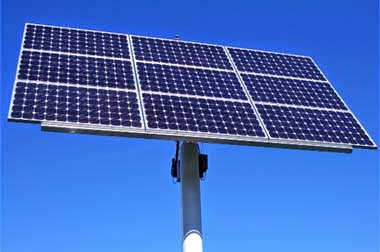
by jboullion | Mar 19, 2015 | Uncategorized
Recently, two anti-solar opinion pieces appeared in the publication Utility Dive. The first, by Dr H. Edwin Overcast, favors increased fixed rates for solar customers as a solution to the solar “problem.” The second, by Dr. Ashly Brown, claims solar customers do not deserve to be reimbursed at full retail value for the electricity they sell back to the grid. RENEW’s Executive Director Tyler Huebner and Senior Attorney at the Environmental Law and Policy Center Brad Klein teamed up to write a response to Dr. Overcast and Dr. Brown on why “data is the key to determining solar’s true value.”












